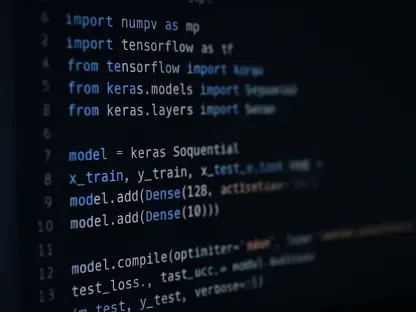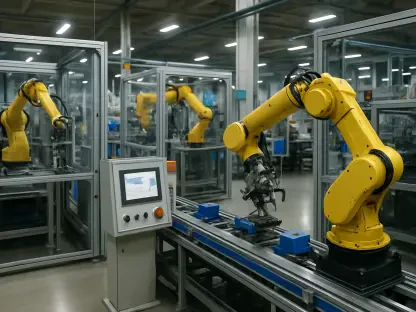In this insightful conversation with Anand Naidu, an expert proficient in both frontend and backend development, we delve into the evolving landscape of AI networking technology. With the growth in AI systems, the networking field has changed dramatically, moving away from older methodologies to embrace more scalable, efficient systems. Anand provides a deep dive into why and how Ethernet technology has become central to modern AI networking, challenging several longstanding myths and assumptions.
Can you explain how Ethernet has become the de facto networking technology for AI at scale?
Ethernet’s rise as the foundation for AI networking largely stems from its performance capabilities that meet or surpass legacy technologies. Most of the large GPU cluster deployments in recent years utilize Ethernet, which provides a robust ecosystem, extensive vendor support, and faster innovation cycles compared to alternatives like InfiniBand. As AI systems scale, Ethernet adapts with its ability to build clusters that reach hundreds of thousands of GPUs, proving its scalability and efficiency for AI workloads.
Why do you believe Ethernet is a better choice for large-scale AI networks compared to alternatives like InfiniBand?
Ethernet offers an unmatched ecosystem that fuels rapid innovation. While InfiniBand may have sufficed in the past, it wasn’t designed for the current scale demanded by AI systems. Ethernet’s adaptable nature aligns well with the growth and complexity of AI infrastructure, offering not only performance but also flexibility and openness that are essential for modern applications.
How has the scaling of AI systems affected the assumptions about using separate networks for scale-up and scale-out?
With the dramatic expansion of scale-up domains, the old practice of using separate networks for scale-up and scale-out is no longer cost-effective or efficient. Today, we design systems with significantly more GPUs, and leveraging a single, unified network like Ethernet simplifies operations and reduces the risks associated with managing multiple network technologies.
Can you elaborate on the benefits of using a single, unified network like Ethernet for AI networking?
A unified Ethernet network supports both local and cluster-wide connections, simplifying network management and operations. This reduces costs and complexity while fostering innovation and flexibility with an open ecosystem. Ethernet provides fungibility at the interfaces, ensuring seamless integration and operation across different AI system components.
What is the Scale-Up Ethernet (SUE) framework, and how does it contribute to the standardization of AI networking?
The Scale-Up Ethernet (SUE) framework is an initiative aimed at pushing the industry toward a standardized AI networking fabric. By contributing this framework to the Open Compute Project, it helps create a cohesive standard that ensures Ethernet remains a versatile and scalable solution for AI networking needs, supporting the convergence of multiple interface technologies.
Why are proprietary interconnects and exotic optics considered outdated for today’s AI network demands?
Today’s AI networks demand flexibility and the capacity for customization, which proprietary interconnects and exotic optics fail to provide. Ethernet supports a range of interconnect options including co-packaged optics and various optic modules, allowing for tailored solutions based on specific performance or economic requirements. This flexibility is crucial for meeting the evolving needs of AI systems.
How does Ethernet offer flexibility and openness in terms of interconnect options?
Ethernet supports a variety of interconnect options, including third-generation co-packaged optics, module-based retimed optics, and the longest-reach passive copper. This means that users are not restricted to a single solution, but can choose the most suitable interconnect for their specific power, performance, and financial goals, ensuring comprehensive support and adaptability.
What advancements in Ethernet switches, such as Tomahawk 5 & 6, help eliminate the need for proprietary NIC features?
Modern Ethernet switches like Tomahawk 5 and 6 integrate features directly into the switch hardware, such as load balancing and rich telemetry, reducing the need for high-power, programmable NICs. These integrated features help lower costs and power consumption, making networking more efficient and allowing the focus to remain on core computing resources like GPUs.
How do you see the trend of embedding NIC functions into XPUs evolving in the future?
This trend will likely continue, as integrating NIC functions into XPUs simplifies network architecture and reduces dependency on external components. This aligns with the broader industry trend towards reducing complexity and increasing the efficiency of AI systems, paving the way for more powerful and streamlined AI infrastructures.
What are the advantages of using Ethernet over matching the network to a specific GPU vendor for AI workloads?
Using Ethernet decouples AI infrastructure from any specific GPU vendor, fostering a more open and scalable system. Ethernet’s vendor neutrality allows for diverse network topologies and supports innovation, enabling easier scaling and the ability to optimize workloads without being constrained by proprietary hardware compatibility issues.
Can you discuss some network topologies that Ethernet enables, making it appealing for diverse AI applications?
Ethernet supports a wide variety of network topologies like Clos or fat-tree architectures, which provide high bandwidth and resilience. These configurations enable efficient, fault-tolerant systems that are crucial as AI networks expand and become more sophisticated. Ethernet’s versatility is key to adapting to different AI applications’ requirements.
How does the vendor-neutral nature of Ethernet support innovation in AI-optimized collective libraries and workload-specific tuning?
Vendor-neutrality means that developers and architects can experiment and innovate without constraints imposed by monopolic technology providers. This openness allows the creation and optimization of AI-specific collective libraries, enhancing performance by fine-tuning workloads at both the scale-up and scale-out levels. It catalyzes innovation and iterative improvements across the AI landscape.
Why might it be time for some AI architectures to rethink assumptions from five years ago?
The pace of AI development has radically outstripped the expectations of five years ago, rendering many past assumptions obsolete. As AI architecture grows in complexity and scale, the need to adopt more open and flexible systems like Ethernet is crucial. This shift reflects a broader necessity to embrace technologies that can adapt to rapid innovation and evolving operational demands.
How has networking shifted from being an afterthought to a strategic enabler in AI performance and scalability?
Networking is now recognized as a core component of AI architecture, essential for achieving high performance and scalability. As AI workloads have grown in complexity, so has the need for a robust networking infrastructure, transforming it from a mere utility to a vital component. Ethernet has become the backbone that enables the scalability and efficiency requirements of modern AI systems.
Could you share more about Broadcom’s role and innovations in the Ethernet switch ecosystem?
Broadcom has been pivotal in advancing Ethernet technology, introducing breakthrough products like the Tomahawk 6 switch. With its extensive portfolio, Broadcom has driven the capabilities of Ethernet, supporting expansive AI architectures and responds to the demand for scalable, reliable, and efficient networking solutions.
How do Ethernet technology advancements support the scalability and power efficiency required by modern AI systems?
Modern Ethernet technologies, such as advanced switching capabilities and integrated features, reduce power consumption and improve efficiency, making them ideal for AI’s growing demands. These advancements support scalability by enabling seamless connectivity across vast networks of GPUs, ensuring that performance scales with network size, while maintaining power efficiency.
Do you have any advice for our readers?
For anyone working within the AI infrastructure domain, it’s crucial to not cling to outdated ideas about networking. Embracing flexible, standardized technologies like Ethernet can facilitate growth and innovation much more readily than proprietary systems. Focusing on open and scalable networking solutions will ensure you’re prepared for the next wave of AI advancements.









